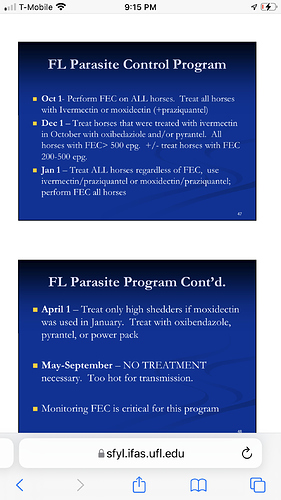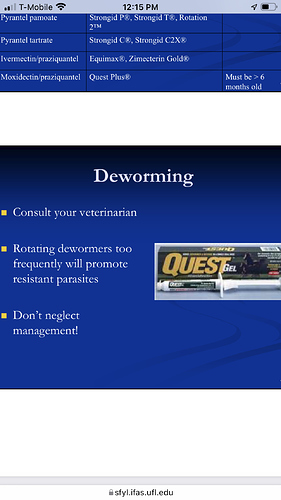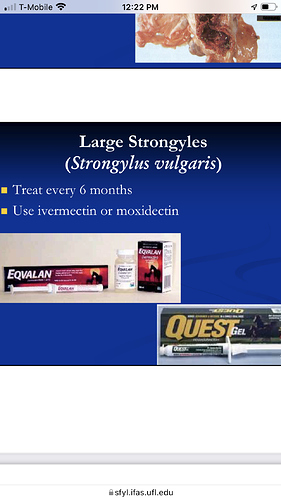Horsemen’s Lab, Dover (I think they still do?) Smart Pack are mail in FEC services I can think of offhand.
Yes, that is a great option. But even mail in can be cumbersome for large facilities with many horses!
For years I’ve been considering hosting a clinic/class on how to do your own. But I worry about the legal ramifications of training people in something akin to medical diagnostics.
Another option would be to pay a lay person a flat rate to come out and do them periodically for a large farm.
An Ag Agent friend of mine has hosted how to DIY fecals. Maybe you can talk to your county extension office and see if they do anything similar?
It’s not really medical diagnostics though. Anyone can go online to find charts on how to identify what’s what, whether strongyle eggs, dust particles, pollen, etc. There are lots of sites that explain how to do the whole process. Learning to ID and count, that’s not medical advice.
then they can follow the AAEP guideline 
For me, with one horse, freezing a bottle, finding a mailing box and getting to the post office in a timely manner is already too complex. I have zero follow-through.
I wonder if you could set up an Extension workshop for this. They will teach 4-H kids and adults, you’re off-the hook. Or horse council/similar?
Edit- JB beat me to it. Great minds .
This is the university of fl’s suggestion for FL horses.
Based on this, it seems a low shedder would go from Jan to October without any treatment. How do we feel about leaving Bots untreated for 9 months? Also, if treating in Oct and Jan I wonder when it would be better to use Quest or Ivermectin to promote dung beetles?
The life cycle of the bot is such that it shouldn’t be an issue, assuming you don’t still have bots actively laying eggs in January.
Thank you 
And apparently when they did the scope they were freaking out thinking the horse had some sort of weird new tumor type growths. Until they moved. My friend, horse’s trainer, was describing what they looked like and how spectacular the scope was to watch, and I was like, yeah, so bots, right? (Yellow conical shaped tumors? Really? WTF?) Lots of vets around here give that same advice about not deworming, or maybe just using ivermectin alone after first frost only. 
I do appreciate this, but wanted to be sure there were no geographic or climate considerations given where I live that I wasn’t accounting for.  I really am trying to do right here! Sometimes having a person who is very, very comfortable with protocols and best practice to distill the information down is extremely helpful, particularly for over thinkers like me, who are able to tie ourselves in knots pretty easily. I have no shame in asking for help when I’m confusing myself by reading a lot of information that doesn’t necessarily mesh.
I really am trying to do right here! Sometimes having a person who is very, very comfortable with protocols and best practice to distill the information down is extremely helpful, particularly for over thinkers like me, who are able to tie ourselves in knots pretty easily. I have no shame in asking for help when I’m confusing myself by reading a lot of information that doesn’t necessarily mesh. 
This doesn’t make sense:

There’s NO reason to deworm a low shedder 3 month after the Oct 1 deworming, especially if you used moxidectin
There’s NO reason to treat any horse 2 months after the Oct 1 deworming if you used ivermectin, but especially if you used moxidectin.
There’s NO reason to use pyrantel unless you have proven it works on a farm - they even talk about how resistant strongyles are with that.
April 1 is a valid deworming period for all the horses regardless of shedder status, to get tapeworms and bots again, if nothing else. But NOT anything other than ivermectin or moxidectin, + praziquantel.
Oxibendazole can be very useful against strongyles, so is potentially valid to use with the extra 1-2 dewormings the Mod or High shedders need
ALWAYS do FEC reduction testing (FECRT) with fenbendazole and pyrantel pamoate. If they are useless on YOUR farm, don’t use them If they work on YOUR farm, they make for a good alternative as an additional deworming for the mod/high shedders, OR in place of Equimax if you use it in a double dose to kill both strongyles and tapeworms. That won’t kill bots though.
The recommendation for no treatment May-Sept is valid, You want strongyle eggs lying in the pasture to be killed by the sun and heat, not by drugs, if at ALL possible. But if you have a mod/high shedder you may still need a treatment during that time - do a FEC first: 10-12 weeks after the Spring ivermectin, or 14-16 weeks after the Spring moxidectin.
It seems you’re not a fan of their recommended protocol for FL.
I’ve not tried this schedule myself, but I do appreciate them trying to come up with a plan for our particular climate.
Well, mostly it reads ok. but the parts I called out just don’t.
You don’t deworm again 3 months after moxidectin, or 2 months after ivermectin, without a FEC proving you need it. You MIGHT need it, as there are shortened ERPs (egg reappearance periods) with those 2 drugs, as a form of resistance. But you need proof, not just deworming because a certain time has passed.
Barring any shortened ERP, ivermectin works for about 8 weeks, and moxidectin for about 12 weeks. That’s their standard ERP - 8 and 12 weeks respectively. Don’t deworm within that timeframe unless you’re using, say, double pyrantel to get tapeworms because your iver/moxi didn’t include praziquantel
This is what I meant by the strategy being the same no matter where you are, but the output (who to deworm, when, and with what) depends on what you put into it - FECs, time of year, temperatures during that time, etc.
You really don’t want to deworm when temps are reliably above 85% unless a horse proves he needs it. That’s so that the environment can kill things without exposing them to drugs, again.
You don’t want to deworm when temps are reliably below 45*, unless a horse proves he needs it, as the strongyle eggs aren’t maturing into infective larva.
This means the “don’t deworm due to heat” is a concern in the South, and “don’t deworm due to cold” is the deal in the North.
Perhaps I am misinterpreting the slides or misunderstanding the 2/3 month timeframes.
I read: Oct, FEC all horses, treat all horses with ivermectin or moxidectin plus praziquantel. Dec treat high shedders again if they were treated with ivermectin in October (so two months after) and maybe treat moderate shedders again if they got ivermectin in October. Jan fec all; treat all horses with ivermectin or moxidectin (use with praziquantel). So that’s three months after the treatment in October. Then April treat high shedders again, three months after the Jan treatment. So for low shedders that would be two treatments three months apart in the mild FL winter that is likely very hospitable to worm growth and then nada during the brutal heat.
As a layperson, I thought the syntax of the December bullet point had some opportunities for improvement regarding clarity.
I’m also curious as to what parts of FL this is really focusing on. The climate in West Palm is very different than my climate in Pensacola. In my area, a Jan treatment is likely fairly good timing if one wanted to treat after a “hard frost” though since it never stays cold for very long even here, I’m not sure that’s really a consideration. Nighttime lows might dip below 45 consistently but daytime highs are almost always above 45 all winter, in my area.
I’m presuming that dung beetles in FL would more likely be dormant in Jan than October. So if one was going to try this protocol than QP in October and then Equimax in Jan might be better than the other way around.
I was also curious about a sentence that seemed to indicate rotating wormers wasn’t advisable. I couldn’t figure out if they were trying to say, just use QP or just use Equimax or what.
I think this is interesting discussion as here we have a relatively recent vet school published reccs claiming to be following AAEP guidelines, using FEC and FECRT, taking local climate conditions and local research into account and still it’s questionable. No wonder horse owners are confused!
You’re reading it right, and that’s what I disagree with.
You NEED to wait 4 weeks or so after the ERP for a given drug (so 4 weeks after 8 weeks for ivermectin) do to a FEC to see if that horse needs to be dewormed again. By just blindly using ivermectin 8 weeks after ivermectin, you don’t know what you’re targeting, and are potentially speeding up resistance by not having any (or many) adults to kill, but potentially a decent number of juveniles who won’t be killed but will be exposed.
At least wait another 4 weeks to give the bulk of the juveniles to mature to adults so you can kill them.
It says “Oct 1- perform FEC on ALL Horses. Treat all horses with iver/moxi + prazi” I’m all on board with that Fall deworming for all horses regardless of FEC.
But if you treat low shedders on Oct 1, there is absolutely no reason to treat them again on Jan 1. They don’t need anything else until April 1. They’re low shedders. There’s nothing to target on Jan 1
I think (!!) the Dec 1 is saying “for horses who had a high FEC (>500) on Oct 1, treat them with oxi/pyrantel” (very iffy, per my previous comment and resistance), and then I THINK the rest says "if you want to , also treat the moderate (200-500) horses, at least that’s how I read the +/-
what’s the whole sentence? (so I don’t have to scroll back through everything lol). On the surface, it seems to mean don’t just go rotating dewormers like we used to do back before resistance was an issue. If that’s what she means, then I agree BUT, that also flies in the face of the suggestions of oxi and pyrantel, because she does list the chart on their resistance, but then doesn’t anywhere say how to use FECRTs to determine if any of those are effective on a given farm
Ok that’s the part I was missing from the 2/3 month timing.
I see so presumably if one used ivermectin plus praziquantel in Oct then doing a repeat FEC in Jan to see if maybe said horse needs additional treatment is warranted but if one had used QP in Oct then the better time frame would be Feb for a repeat FEC to see if maybe addtl treatment is warranted.
This bit here regarding rotating dewormers. Not much context to draw from.
Then there is this slide which seems to contradict their own protocol unless they mean treat every 6 months if large strongyles show on FEC? Or maybe not a priority since they are less of a concern these days
Totally sympathize with those saying it’s confusing for horse owners. When I googled, deworming protocol FL, the first hit was “deworm every two months with rotating products” and the second hit is this piece from UF.
I like the circa 1999 pictures of dewormer packaging. 
I’m pretty sure this presentation is what I as a teacher affectionately refer to as “Frankenslides.” Meaning it was an old presentation that has been edited, chopped, and updated so many times over the years and now there are typos older than the audience members.
I find bots perplexing. Back in the day pre Ivermectin we only had organophosphates that had to be tubed into the horse to kill bots. Bot eggs on a horse were commonly seen. Then came Ivermectin and I almost never saw bot eggs for 20 to 30 years. Now I was doing self care with a small herd that didn’t change. I did board for about 1-2 years and then bought this property. I wormed each horse before it got here and did the daily wormer for about a month after they got here ( this was before the current protocols). Two horses on 15 acres of pasture where horses had not been before. Zero egg counts despite infrequent worming.
Didn’t see a bot egg for 20 years. I did purchase third horse that had a high fecal count when I got her ( and was a total PITA to tube worm) but we got her under control. Still not bot eggs for a few years after that. Then a few years ago I started seeing some bot flies and eggs. Where did they come from??? The closest horses are a good half mile down the road and we are separated by wooded land. Vet suggested deer. Hmmmm - that doesn’t sound right. Yep deer get bots but not horse bots - they are species specific.
Amped up worming and haven’t seen an egg in several years. Problem child gets paste wormed when her teeth are done and she is still drugged. That solved that problem! I still don’t know where the bots came from unless maybe one bot multiplied into hundreds gradually before I noiced.
Exactly 
Yeah, that’s just weird to say, it’s much too subjective. Most people only have ivermectin and moxidectin to choose from, and while they’re the same drug class (macrocyclic lactone) at least by alternating between those you aren’t encouraging resistance any more than the fact that you still only have those to use. But if you do find that fen or pyrantel are effective on YOUR farm, then using that as a 3rd and even 4th deworming for the mod and high shedders, at least keeps the -ectins from being used 3-4 times a year
yeah, another not-well-clarified slide there. She SEEMS to be saying the all need to be dewormed every 6 months, if for no other reason than to target bots and tapeworms. In the process you’d be targeting errant strongyles, small OR large, in the otherwise “low” shedder. But yes, also, the larges are less of a concern than the smalls are, but the same principal holds 
uggghhhhh 

That actually makes perfect sense. Good intentions, pretty good stuff pieced together, but the start to finish was never looked at to see how to flowed, to see any contradictions or disrepancies.
They seem to be cyclical, with that defined as something I don’t fully understand, as it doesn’t seem to follow any pattern of dry vs wet this Summer or Fall, vs last, etc, but it may be established somewhere and I haven’t looked for it. It’s like ticks - a black mice boom now means more ticks later 
I’d expect that, actually  Most horses don’t need deworming for strongyles, and only rarely do adults need help with ascarids (they’re usually old, or sick, or otherwise immuno-compromised)
Most horses don’t need deworming for strongyles, and only rarely do adults need help with ascarids (they’re usually old, or sick, or otherwise immuno-compromised)
Maybe. And now, I’m really curious about their cycles. Are the like cicadas? Does it take a really wet cycle for something to happen? Hmmm.
I was considering working with a new vet (the idea of having more than one or two) and when he brought out his recommended program selling the year-long pack just as you say, I was so bothered that I could not even consider developing a relationship. I mean…seriously?
I made a small donation to UK’s Parasitology program and just received an update letter from Dr. Nielsen and he mentioned some alarming stats. One, they are seeing ivermectin and moxidectrin resistance developing and spreading.
VERY concerning. And those were his words too.



